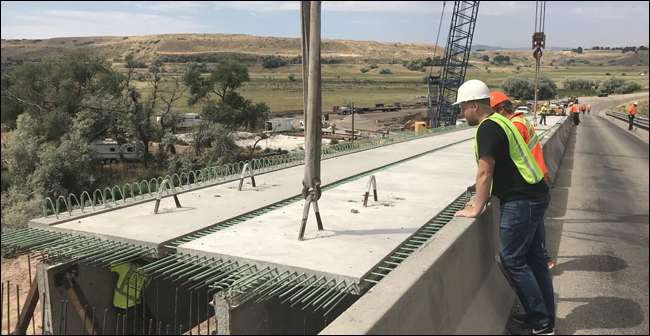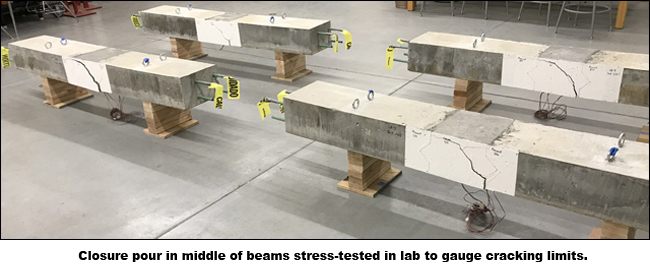

Cost-Effective Concrete Connects
Precast Elements,
Accelerating Bridge Construction in Idaho
ITD is increasingly using Accelerated Bridge Construction (ABC) methods in order to shorten the amount of time required in bridge-replacement projects. Construction time may be reduced 30-70% — sometimes even more — by using ABC compared to conventional methods. This increases public and worker SAFETY by lowering exposure to construction activities and also increases MOBILITY and ECONOMIC OPPORTUNITY by minimizing traffic interruptions and delays. In other words, ABC goes hand-in-hand with ITD’s mission.
Most of the ABC bridge replacement projects in Idaho involve prefabricated components transported to the job site and quickly assembled in the field. The cost is usually 30-40% higher than conventional methods, so ABC is not always used. However, increasing safety, increasing quality, and improving mobility make ABC popular when replacing bridges on major highways with heavy traffic volumes.
Traditional bridge-span construction is labor intensive and time consuming. For these reasons, ITD and many other DOTs often use precast concrete Deck Bulb-T girders in ABC projects. After being built side-by-side, the girders are longitudinally connected and their wide and thick top flanges serve as a driving surface rather than a cast-in-place deck. Although Deck Bulb-T girders have existed for many years, their use in the past was limited to short-span bridges on low-traffic routes, because of the poor performance of the traditional welded-tab connections between girders under high-traffic volumes. The increasing need for fast bridge construction on heavily trafficked roads meant a new, more reliable connection had to be developed.
To address the issue, the Federal Highway Administration sponsored several research projects regarding the use of an Ultra High Performance Concrete (UHPC) to connect precast elements in bridge construction. Research showed that due to its superior qualities (high compressive strength of up to 26,000 psi, excellent adhesion, and long-term durability), UHPC could be successfully used in ABC applications. As a result, many DOTs, including ITD, now routinely incorporate this material in bridge construction.
ITD’s Bridge Section has developed a standard using UHPC in a narrow six-inch wide closure pour to connect Deck Bulb-T girders, which has been used in several bridge projects so far. However, due to its proprietary nature and limited availability, UHPC is extremely expensive in Idaho ($10,000 - $15,000 per cubic yard). It has to be batched in small quantities at the bridge site, its placement is labor intensive and requires very rigorous quality controls in the field.
Facing these drawbacks, ITD’s bridge design engineer, Leonard Ruminski, P.E. (TE-2), suggested substituting the UHPC material with more conventional High Early Strength (HES) concrete in 10-inch wide closure pours between Deck Bulb-T girders. The material is based on ITD’s Class 50AF concrete standard, with polypropylene fibers added, achieving compressive strength of about 8,500 psi. This closely matches the strength of precast girders.
Costing about $700 per cubic yard, with a delivery and placement process similar to those of the conventional concrete, the cost savings per each average span is estimated to be about $50,000. A number of Deck Bulb-T girders are built every year in Idaho, so the ongoing long-term cost savings could be substantial.
The first pilot bridge project using HES concrete in the modified closure pours is currently under construction on Idaho Highway 36 over Bear River, west of Preston. Other similar bridges will be constructed in the near future.
ITD’s Bridge Section recently engaged a research team at Idaho State University (ISU) to carry out a research project titled “Effectiveness of High Early Strength Concrete Class 50AF with Polypropylene Fibers as a Cost-Effective Alternative for Field-Cast Connections of Precast Elements in Accelerated Bridge Construction.” The purpose was to evaluate the suitability of the alternative material through a series of laboratory tests, experiments with laboratory specimens, and Finite Element (FE) computer modeling.
Phase 1 of the research project started in January 2017 and ended in July 2018. The researchers considered and tested several alternatives and selected the mix design with the most desirable properties. Using results from the laboratory and experiments, the computer modeling was created and refined. The model was subsequently loaded with the representation of the AASHTO design truck and fatigue design truck, and the connection between the girders was analyzed under three AASHTO bridge criteria: 1. Strength (for flexural capacity), 2. Service (for controlling flexural cracking), and 3. Fatigue (for infinite load-induced fatigue life). The analysis showed that the proposed new connection satisfied all three.
Phase 2 of the research project is currently underway and includes installing sensors on the Bear River Bridge. Once constructed, the bridge will be loaded with an actual truck, and the corresponding stress and strain data will be collected and analyzed. Test results will provide Idaho bridge designers with a better understanding of the behavior and performance of the connection points. The long-term performance of bridges with these connections will be monitored, evaluated, and compared with UHPC connections.
If proven acceptable and fully reliable, Idaho engineers will have an effective and economical solution for Deck Bulb-T girder connections in ABC bridge construction projects.
Contributing members of the ISU research team included: Arya Ebrahimpour, Ph.D., P.E. (Principal Investigator), Mustafa Mashal, Ph.D., P.E. (Co-Principal Investigator), Max Casanova (Graduate Student), Utsa Rashique (Graduate Student), Chris Clauson (Graduate Student), and Ali Shokrgozar (Graduate Student).
Contributing members of the ITD team included: Matt Farrar, P.E., ME-2 (State Bridge Engineer), Dan Gorley, P.E., ME-1 (Project Manager), Leonard Ruminski, P.E., TE-2 (TAC member that developed the project), and Ned Parrish (Research Program Manager).


Published 10-19-18